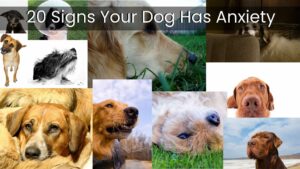So, what are the signs your dog has anxiety?
There is nothing more heartbreaking than seeing your dog suffer from anxiety. Anxiety in dogs can manifest itself in a variety of ways, including shaking, panting, pacing, and excessive barking or whining.

Any/all links on this site may be affiliate links, and if you make a purchase through one of them, I will earn a small commission at no extra cost to you. Read the full affiliate disclosure here.
If your dog is exhibiting any of these behaviors, it’s important to take action to help them feel more relaxed and comfortable.
One of the first signs of anxiety in dogs is usually panting. Panting is a normal behavior for dogs, but if your dog is panting excessively or constantly, it could be a sign of anxiety.
Dogs may also pace back and forth when they’re feeling anxious or restless. This can be a result of boredom or frustration, but it can also be a sign of an underlying anxiety disorder.
If your dog is exhibiting any of these signs, it’s important to talk to your veterinarian about possible treatment options.
There are a variety of medications and supplements that can help reduce anxiety in dogs, and your vet can help you choose the best course of treatment for your pet.
In addition to medical treatment, there are a number of things you can do at home to help reduce your dog’s anxiety.
Exercise is a great way to relieve stress and burn off excess energy, so make sure your dog is getting plenty of exercise every day. A tired dog is a happy dog, so walks, runs, and playtime will go a long way towards reducing your pet’s anxiety.
You should also create a calm, quiet environment for your dog. This means avoiding loud noises, such as music or television, and providing a safe space for them to retreat to when they’re feeling overwhelmed.
A crate or dog bed in a quiet room can provide a safe haven for your anxious pet.
Finally, make sure you’re providing plenty of love and attention to your dog.
Dogs are social creatures, and they need human interaction to feel happy and secure. Spend time cuddling, playing, and just talking to your dog every day to let them know they’re loved.
20 Alarming Signs Your Dog has Anxiety
Ok, lets dive right in and take a look at the 20 signs your dog has anxiety.
1. Your Dog May Pant Excessively, Even When It’s Not Hot
If your dog is excessively panting, even when it’s not hot, it might be a sign of anxiety. Other signs include pacing, shaking, and hiding. If you think your dog might be anxious, talk to your veterinarian. They can help you figure out what’s causing the anxiety and how to best treat it.
2. Your Dog Shakes or Trembles, Even When They’re Not Cold

There is nothing more heartbreaking than seeing your dog suffer from anxiety.
One of the most common signs of anxiety in dogs is shaking or trembling. This can happen even when they’re not cold or wet, and is usually a sign of fear or stress. If you notice your dog shaking or trembling, it’s important to take them to the vet to rule out any medical causes.
3. My Dog Refuses to Eat or Drink
Has your dog lost its appetite? Do they no longer drink water? These are common signs of anxiety in dogs.
If your dog is not eating or drinking, it’s important to take them to the vet to rule out any possible medical reasons for their lack of appetite. If there are no medical explanations, then chances are your dog is experiencing some form of anxiety.
4. Your Dog Becomes Withdrawn And Stops Playing
Is your dog usually the equivilant of the energizer bunny, but all of a sudden they’re low key and not interested in playing?
This could be a sign that your pup is experiencing anxiety. Just like humans, dogs can get anxious for a variety of reasons.
It could be something as simple as a change in routine or a loud noise that scares them.
If your dog is showing any of the following signs, it’s possible they’re feeling anxious and you should take them to the vet to rule out any health concerns.
related article in ourDogsWorld101.com
The Furbo Dog Camera is a home security camera that allows you to keep an eye on your furry friend while you’re away. If your dog is suffering from separation anxiety then you need to read a recent article we did on the Furbo Dog camera below.

5. Your Dog Hides From People or Other Animals

If your dog is hiding everytime someone new comes over, it could be a sign of anxiety. Dogs that are anxious may also bark excessively, cower or crouch, tremble, pant, or pace.
If your dog is showing any of these signs, it’s important to consult with a veterinarian to rule out any potential medical causes and develop a treatment plan.
6. Your Dog Pees or Poops in The House, Even Though They’re Potty Trained
As a dog owner is there anything worse than pee or poop in the house? However did you know that your dog may not be doing this ‘on purpose’ and may in fact be suffering from anxiety?
7. Your Dog Will Pace Back and Forth Endlessly
Pacing back & forth is a common sign of anxiety in dogs. If you notice your dog paces more often than usual, or if they seem restless and can’t seem to settle down, it could be a sign that they’re feeling anxious.
8. Your Dog Chews on Themselves Until They Bleed
They chew on themselves until they bleed. It’s a graphic and disturbing image, but it’s one that accurately describes the destructive behavior of many dogs who suffer from anxiety or boredom.
This type of self-harm is often seen in dogs who are anxious or stressed, as they may start to excessively lick or chew on their skin as a way to deal with their negative emotions.
In some cases, this can lead to the dog causing serious injury to themselves, as they may continue to lick or chew until they break open the skin and start to bleed.
While this behavior may seem odd to us, it’s important to remember that dogs are not humans and thus don’t process things in the same way that we do.
If your dog is exhibiting this type of behavior, it’s important to seek professional help in order to address the underlying issues causing the anxiety or stress.
Ignoring the problem will only make it worse and could lead to your dog seriously harming themselves.
9. Your Dog Startles Easily At Any Noise or Movement
Another sign your dog could be suffering from anxiety is that they startle easily at any noise or movement.
This is often a result of them being constantly on edge and feeling like they’re in danger. If your dog is always on the lookout for potential threats, it’s likely that they’re suffering from some form of anxiety.
If you notice this behavior in your dog, it’s important to take steps to help them feel more relaxed and secure.
10. Your Dog Seem Always on Edge
Is your dog always on edge, like they’re about to bolt at any moment?
If so, there could be a number of reasons why. It could be that they’re nervous or anxious, which is completely normal. Or, it could be a sign of something more serious, like separation anxiety or fearfulness.
If your dog is always on edge and you’re not sure why, the best thing to do is to talk to your veterinarian. They can help you figure out what’s going on and how to best help your dog. In the meantime, here are some things that may help:
- Make sure your dog has plenty of exercise; a tired dog is a happy dog!
- Consider using a calming supplement or natural remedy to help your dog relax.
- Create a safe, comfortable space for your dog to relax in, away from any triggers that may be causing their anxiety.
11. Your Dog Is Shedding More Than Usual
All dogs shed, however dogs that could be suffering anxiety may shed more than usual. If you notice your dog is shedding more than they normally do, it could be a sign that they are experiencing anxiety.
12. Your Dog Develops Hot Spots on Their Skin From Excessive Licking or Biting
Hot spots are a common sign of anxiety in dogs. If your dog is licking or biting excessively, it could be a sign that they are anxious.
Hot spots can also be caused by other things, such as allergies or infections, so it’s important to talk to your veterinarian if you notice any changes in your dog’s behavior.
13. Your Dog Has Difficulty Settling Down and Sleeping Through The Night
Dogs love to sleep. In fact, they spend about 12-14 hours a day snoozing. But some dogs find it hard to settle down and sleep through the night. This can be caused by anxiety or excitement.

If your dog is having trouble sleeping, there are a few things you can do to help them relax.
One way to help your dog relax is to create a calm environment for them to sleep in. This means keeping the noise and activity level down in the room where they sleep.
You may also want to try using a calming supplement such as CBD oil or Rescue Remedy.
Another way to help your dog relax is to give them a massage before bedtime. This will help to release any tension they may be feeling and make them sleepy.
Finally, make sure your dog has a comfortable place to sleep. This may mean using a dog bed or blanket. If your dog is used to sleeping in their crate, you may want to try putting a blanket over the top of it to make it more cozy.
If your dog is still having trouble sleeping, talk to your veterinarian about other options that may be available. There are many products on the market that can help to ease anxiety and help your dog sleep better at night.
14. Your Dog Becomes Clingy and Attached To You

If your dog seems to be following you everywhere you go, it may be a sign of anxiety. Dogs with anxiety often become clingy and attached to their owners as a way to cope with their fear or insecurity.
If you think your dog may have anxiety, talk to your veterinarian about ways to help ease your pet’s anxiety and improve their quality of life.
15. Your Dog Stops Enjoying Things They Used To Love
Has your dog stopped enjoying the things they used to love doing? Do they seem off or anxious when you leave them alone or take them to new places? If so, your dog may be experiencing anxiety.
There are a number of different types of anxiety that can affect dogs, and it’s important to be able to identify the signs so you can get your furry friend the help they need.
16. Your Dog No Longer Likes To Leave The House
Has your dog started to be fearful of leaving the house? Do they seem anxious or stressed when you try to take them for a walk? If so, your dog may be suffering from anxiety.
17. Your Dog Starts To Vocalize More
Dogs with anxiety may start to vocalize more, whimpering or whining even when nothing seems to be wrong.
This is often a dog’s way of trying to self-soothe and calm down. If your dog is starting to vocalize more than usual, it may be a sign that they’re feeling anxious or stressed.
Try to provide them with a safe space where they can feel comfortable and relaxed. You may also want to consult with a veterinarian or animal behaviorist to help you figure out the best way to help your Dog cope with their anxiety.
18. You Notice a Change in Your Dogs Bark
If a dog is suffering from anxiety, you may notice a change in their bark. It may sound higher pitched and distressed.
19. Your Dog Seems Sluggish All The Time
If a dog is suffering from anxiety, you may notice that they seem sluggish all the time. This can be a symptom of many different types of anxiety, including separation anxiety, social anxiety, and even generalized anxiety.
If your dog is exhibiting this symptom, it’s important to take them to the vet to rule out any other potential health issues.
20. Your Dog Seems Generally Unwell and Their Overall Health Deteriorates
While an unwell dog doesnt necessarily point to anxiety as the root cause, it is possible that your dog is experiencing some sort of health condition that is causing them stress and anxiety.
If you notice any of these signs in your dog, it’s important to take them to the vet to rule out any medical causes first. If there are no underlying health issues, then your dog may be suffering from anxiety.
There are many different types of anxiety that can affect dogs, so it’s important to get a professional diagnosis to ensure they get the correct treatment.
Once you know what type of anxiety your dog has, there are many things you can do to help ease their fears and make them feel more relaxed and happy.
With the right help, your anxious dog can lead a normal and healthy life.
Different Types of Dog Anxiety
There are many different types of anxiety disorders that can affect dogs. The most common include separation anxiety, social anxiety, and generalized anxiety disorder. Each type of anxiety disorder can cause different symptoms in dogs.
- Separation anxiety is the most common type of anxiety disorder in dogs. It occurs when a dog is separated from their owner or someone they’re close to. Dogs with separation anxiety may whine, bark, or howl when left alone. They may also pace, pant, or refuse to eat or drink.
- Social anxiety occurs when a dog is fearful of other people or animals. Dogs with social anxiety may bark excessively, try to hide, or cower when around others. They may also tremble or shake.
- Generalized anxiety disorder is characterized by chronic fear and worry. Dogs with generalized anxiety disorder may be scared of many different things and may show signs of stress even when there’s no apparent trigger. They may pant, pace, tremble, yawn, scratch themselves excessively, or have accidents in the house.
If you think your dog might be suffering from anxiety, it’s important to talk to your vet about treatment options. There are many different ways to treat anxiety in dogs, including behavior modification, training, and medication. The best treatment plan for your dog will depend on the severity of their anxiety and what’s causing it.
If you’re concerned that your dog may be suffering from anxiety, look for these common signs. If you notice any of them, talk to your vet about treatment options.
How Can I Help With My Dogs Anxiety?
If you think your dog may be struggling with anxiety or boredom, there are a few things you can do to help them cope.
Providing them with plenty of exercise and mental stimulation can help to tire them out and reduce their anxiety levels.
Try providing them with a safe space, such as a crate or designated area in your home, where they can go to feel calm and safe.
You can also give them chew toys or Kong’s filled with food to help distract them from their anxiety.
Many of our clients have also had great success with the Thunder Shirts, and we have done a full review on these which you can check out here.
related article in ourDogsWorld101.com
Would You Like To Be Able To Talk To And Reward Your Dog Whenever He Or She Feels Anxious?
Check out how you can from anywhere in the world in a recent review we did here at Our Dogs World 101 – “Why We Love The Furbo Dog Camera (And You Should Too!)”

Finally, working with a professional behaviorist or trainer can provide you with specific tools and techniques to help your dog overcome their anxiety or boredom.
If your dog is displaying any of the above behaviors on a regular basis, it’s important to seek professional help.
Anxiety and boredom are serious problems that can lead to more serious behavioral issues if left untreated. A behaviorist or trainer can help you to identify the root cause of your dog’s problem and develop a treatment plan that will address their specific needs.
With the right support, your dog can learn to cope with their anxiety or boredom and live a happy and healthy life.
Signs Your Dog has Anxiety Summary
Dogs with anxiety can benefit from treatment, and there are many ways to help dogs with anxiety. If your dog is struggling with anxiety, please reach out for help. We would be more than happy to work with you and your dog to create a treatment plan that makes life better for both of you. Can we help your dog?
Remember… Owning a dog should be FUN, not a chore!
My name is Mark and I currently live in Australia.
I am passionate about educating Doggie parents and helping you to make the best possible decisions to help your dog live a long, happy and healthy life.
As a Dog trainer & behaviorist I have always used The Dog Solution methods with a 100% success rate.
Feel free to contact us, and stay tuned for updates and informative posts on dog care, training, diet, and much more!
“Dogs do speak, but only to those who know how to listen” – Orhan Pamuk



I’m not a Dog owner myself but love Dogs. This is a very useful post looking for the alarming signs of your loyal one’s anxiety. Dogs have emotions just like us and play a big part in our life, so we must do everything we can to love and cherish them. The number of signs mentioned to look for are very in-depth and provide useful information for current and future Dog owners.
Thanks Oliver
Thank you very much for this valuable and detailed post about dog’s anxiety. I actually have two dogs. So this post is very important to me. Also, the sign you have shown here has sometimes been shown by both of mine. Sometimes there have been cases where they refuse to eat. I think this will help me a lot. When I see such a symptom again, I will help them. Keep posting like this.
Thanks Pasindu
Pleased to meet you both Mark & Saffron. Honestly I don’t know why some people are allowed to acquire animals. Especially when they cause their dogs to have anxiety. We have 2 babies, well they’re not actually babies now, but that’s what I call them. Lol One is a Neo Mastiff (Bear), he’s huge and our other one is a rescued pitball cross (Mia).
These babies of ours are spoilt rotten! I wouldn’t have it any other way lol. They have inner spring beds, tri pillows and fluffy blankets, cooked meals every day and they sleep inside. I speak to Bear and Mia so often I think they understand the dictionary!
Good call recommending that people reach out for support and help. Our animals rely on us 24/7. They need love just as much as our children do. No doubt I’ll be back! Take care.
Shelley
Hi Shelley,
So great to meet another true dog lover.
I love the Neo’s, and that name is so perfect for a Neo, I love it!
Your two sound exactly like mine, Spoiled Rotten! and like you I would have it no other way.
If you get yourself a dog they should be family.
Great work rescuing Mia, she is definitely one lucky dog to have found you!
Would love to get a photo of each to put up on our Facebook group if ever you get a chance. Our Dogs World
Mark
Great post, very well written and informative. I learned a lot from it. Keep up the good work! Having suffered from anxiety for most of my life (it’s gotten better with therapy and medication) I know how awful it is and we certainly don’t want our pets to experience it. It’s good to know what to look out for and how to help
Yes very true.
This is a great article and resource for anyone who thinks their dog may be experiencing anxiety! It’s important to catch the signs early on and give your dog the treatment (or love) that they need to get over their anxiety and thrive. Thanks for taking the time to outline the signs and give a few solutions! Keep up the great work.
Thanks Jordan.